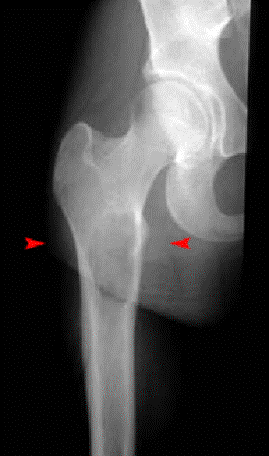The Solitary Bone Cyst (SBC) also known as the simple bone cyst & unicameral bone cyst (UBC) is found mostly in the 5-15 year old range with a male predominance. Most lesions are found in the proximal humerus (50%) and upper femur (25%). SBCs are always found on the metaphyseal side of the physis. In fact, these lesions have an intimate relationship with the growth plate and are considered “active” if they are in continuity with the physis and “inactive” if the have separated from it. This relates to the pathophysiology of the lesion in that active lesions are actively expanding due to hydraulic dynamic expansion from fluid being excreted by the physis. Symptoms are usually absent until enough bone destruction has occurred to threaten or cause a pathologic fracture.
Radiographically, these lytic lesions are located centrally within the metaphyseal portion of bones and can have a pseudoloculated appearance and thin cortical rim (Figure #5). One classic finding is the “fallen leaves” sign where small particles of fractured cortex are found within the most inferior aspect of the cavity. The cysts are grossly filled with serous fluid and the inner lining is a fibrous membrane with giant cells and foam cells.
Figure #5

Solitary bone cyst of the proximal femur
www.aaos.org
Pathologic fractures are a frequent problem in these lesions and steps to avoid this complication are warranted if anticipated. Most fractures will heal without major complication because the periosteum of the bone remains intact. However, most cysts will persist following a fracture.
Initial management of most lesions include an initial aspiration to ensure the diagnosis and concurrent injection with bone marrow or steroid. If aspiration does not produce serous fluid, then re-evaluation of the diagnosis and open biopsy is required to rule out more aggressive lesions such as sarcoma. A large bore needle such as a bone marrow biopsy needle should be employed and these injections should be repeated three to five times over 3 months. Results with this treatment tend to be more favorable in younger patients with active lesions as the macrophage activity is elevated and helps with remodeling. Failure of response to the injections advances treatment to the next level, which includes aggressive curettage and bone grafting. Load bearing bones such as the femur require more aggressive therapy initially, especially if there is an impending fracture. These require aggressive curettage and bone grafting from the start. These bones will often fail dramatically and displace with pathologic fractures leaving a difficult reduction and limited fixation capability due to poor bone stock. Active lesions will recur 50% of the time with this treatment, but inactive lesions fare much better.

